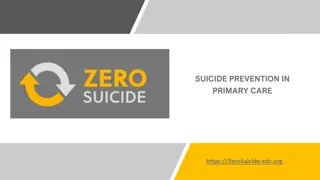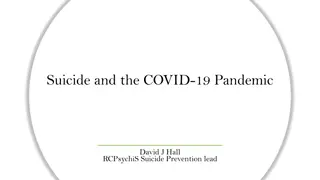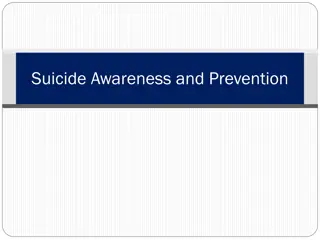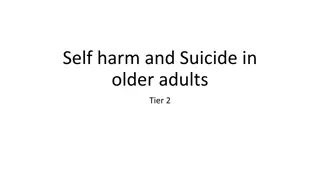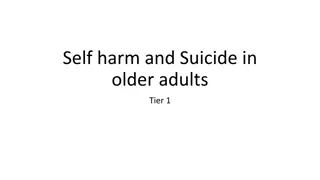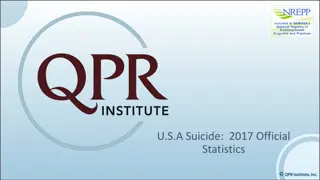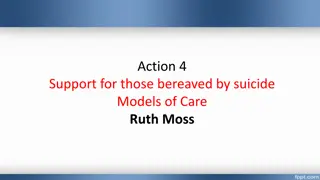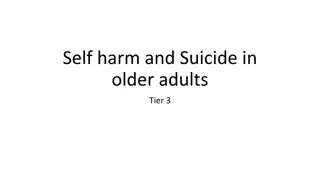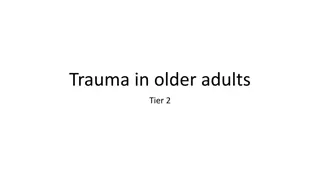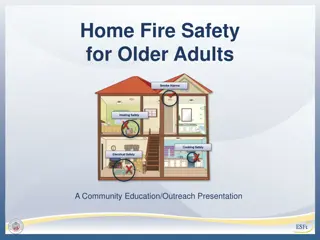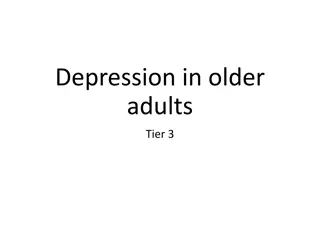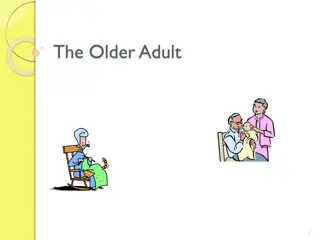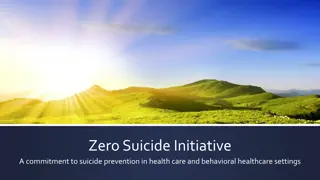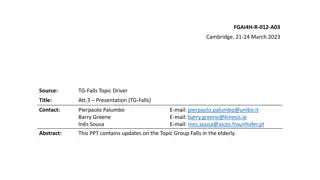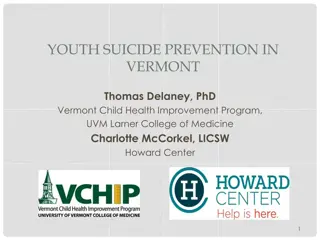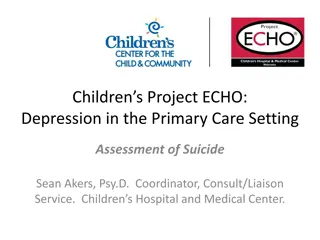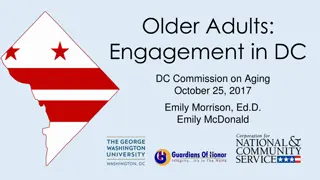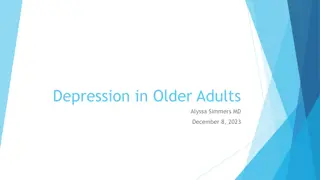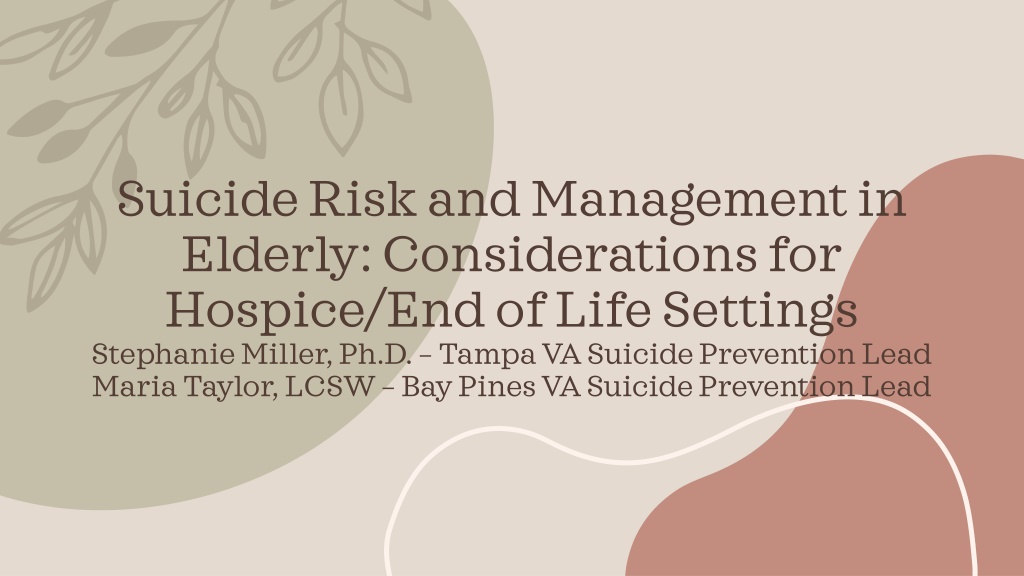
Elderly Suicide Risk Management in End-of-Life Settings
Explore considerations for managing suicide risk in elderly individuals in hospice and end-of-life settings. Learn about risk and protective factors, interventions, and special considerations for this vulnerable population. Gain insights from experts in the field on addressing suicidality in older adults.
Download Presentation

Please find below an Image/Link to download the presentation.
The content on the website is provided AS IS for your information and personal use only. It may not be sold, licensed, or shared on other websites without obtaining consent from the author. If you encounter any issues during the download, it is possible that the publisher has removed the file from their server.
You are allowed to download the files provided on this website for personal or commercial use, subject to the condition that they are used lawfully. All files are the property of their respective owners.
The content on the website is provided AS IS for your information and personal use only. It may not be sold, licensed, or shared on other websites without obtaining consent from the author.
E N D
Presentation Transcript
Suicide Risk and Management in Elderly: Considerations for Hospice/End of Life Settings Stephanie Miller, Ph.D. Tampa VA Suicide Prevention Lead Maria Taylor, LCSW Bay Pines VA Suicide Prevention Lead
Disclosures: Disclosures:None Who am I? Who am I? ~Stephanie Miller, Clinical Psychologist & Team Lead for the Tampa VA Suicide Prevention Program ~Not a SME for elderly/EOL, but have a lot of experience with working with older Veterans and am a SME in Suicide Risk Management & Prevention Special Thanks (contributors): Special Thanks (contributors): Maria Taylor, LCSW Lauren Weber, Ph.D. MIRECC Suicide Risk Management Consultation Program
Overview Introduction 5 Risk & Protective Factors in Elderly 6 Special Considerations for End of Life/Hospice Settings 10 Interventions 13 Contact Information 14 4
Introduction: Elderly: defined as over 65 A growing population: Individuals > 65: 58 million in 2022; projected to be 82 million by 2050 (47% increase) A more diverse population: Non-Hispanic Whites >65 will drop by 15% by 2050 Alzheimer s rates are projected to double by 2050 to 13 million (vs. 7 million in 2024) 5
The Elderly and suicidality Older adults have the highest rates of suicide of all age groups; older WM have 6x greater suicide rate (v. general population); suicide rates for those 80+ are high globally. Among males* over 60: 7-10% report recent (past 2 weeks) suicidal ideations Most older males* who report suicidal thinking aren t involved in MH treatment, likely related to perceptions of stigma associated with receiving MH care and/or distrust of MH providers. Suicidal Ideation rates increase in sub-groups of elderly: 12% of those receiving in home care; 31% of those in nursing homes Desire to Hasten Death Desire to Hasten Death (DHD) vs. suicidality DHD seen as a WNL reaction to suffering, often without suicidal intent Spectrum? Many older adults who think about suicide do not do so within the context of mental illness 6
Risk & Protective Factors in Older Adults & Adults at EOL
Risk Factors Older Adults/EOL: Suffering and Loss Identity Changes, feelings of being a burden Changes in relationships Pain (acute or chronic) physical/psychological; Sleep Firearms: 83% of older Veteran suicide deaths; Firearms: 83% of older Veteran suicide deaths; 71% of suicides among elderly are by firearm 71% of suicides among elderly are by firearm firearms in home as an independent risk factor firearms in home as an independent risk factor Hopelessness Medical/Physical issues especially those leading to functional limitations Delirium Social Isolation/Loneliness linked to suicidal ideation, attempts, behavior and poor physical/mental health outcomes Loss of control, independence, dignity Psychosocial stressors: food/housing insecurity Transitions (ALF, nursing home, hospice) Discharge from Nursing Home can be a higher risk time; as can be the time right after diagnosis or change in prognosis Terminal diagnoses associated with 3x rate of suicidal ideation 8
Protective Factors Advanced Care Planning Goals of Care Conversations Adequate Pain Control Being able to talk about death/dying w/care providers and family Addressing emotional, spiritual, existential needs Connections Palliative Care/Hospice Meaning making/Leaving a Legacy 9
Special Considerations for EOL/Hospice Settings Risk Management: Risk Management: Some Risk Mitigation and Safety Planning discussions may feel Some Risk Mitigation and Safety Planning discussions may feel invalidating invalidating Dignity Preservation Dignity Preservation Relational work Relational work unresolved interpersonal issues unresolved interpersonal issues Risk/Benefit analysis for treatment decisions Risk/Benefit analysis for treatment decisions Risk Assessment Risk Assessment how does it look different in EOL/elderly? Depression screenings and overlap with normative aging experiences Suicide screenings perhaps going to sleep and not waking is a goal for those w/terminal illness Clarify: Suicidal thinking vs. DHD traditional approaches vs. further discussion/dialogue What about Physician Aided dying/suicide inquiries? Discuss fears related to death Discuss fears related to death Minimizing pain/suffering Minimizing pain/suffering Planning for death (comfort care, hospice, advanced Planning for death (comfort care, hospice, advanced directives) directives) Safety Planning/Means reduction Safety Planning/Means reduction 10
Barriers to Conversations around EOL What makes these conversations difficult? Providers: language, training/background Patients/clients: inequitable access to healthcare, providers, negative experiences or beliefs about death/dying, misconceptions about palliative and hospice care, disagreements with loved ones Addressing barriers: Providing space to talk/learn about palliative/hospice care; utilize chaplaincy, team meetings to identify barriers and impact of values/beliefs, facilitate meetings between patient/client and loved ones 11
Special Considerations for EOL/Hospice Validating concerns about death/dying Ways to start the critical conversations: What is most important to you as you approach the end of your life? What concerns you the most when you think about death/dying? Who are the most important people in your life? Should we include them in these conversations? 12
Interventions: Ideally, treatments will enhance dignity and meaning, and EOL care planning can result in reduction of risk (e.g., reduced suicidal thinking/behavior) Discussions about values and acceptance can help individuals connect with what is important to them and reduce suffering as they contemplate EOL. Specifics: Palliative/Hospice Comfort/pain control Dignity therapy, meaning centered psychotherapy, ACT Unfinished business, final wishes Spiritual Support Safety Planning and Lethal Means Safety Again, consider risk/benefit analysis of traditional options (involuntary hospitalization) Lethal Means Safety 13
Recommended Training: SUICIDE PREVENTION AND END OF LIFE - TRAIN FLORIDA - AN AFFILIATE OF THE TRAIN LEARNING NETWORK POWERED BY THE PUBLIC HEALTH FOUNDATION
CONTACT INFO: CONTACT INFO: STEPHANIE MILLER STEPHANIE.MILLER1@VA.GOV 813-972-2000 X105283 thank you REFERENCES/SLIDES AVAILABLE UPON REQUEST MARIA TAYLOR: MARIA.TAYLOR2@VA.GOV 727-398-6661 X14226

